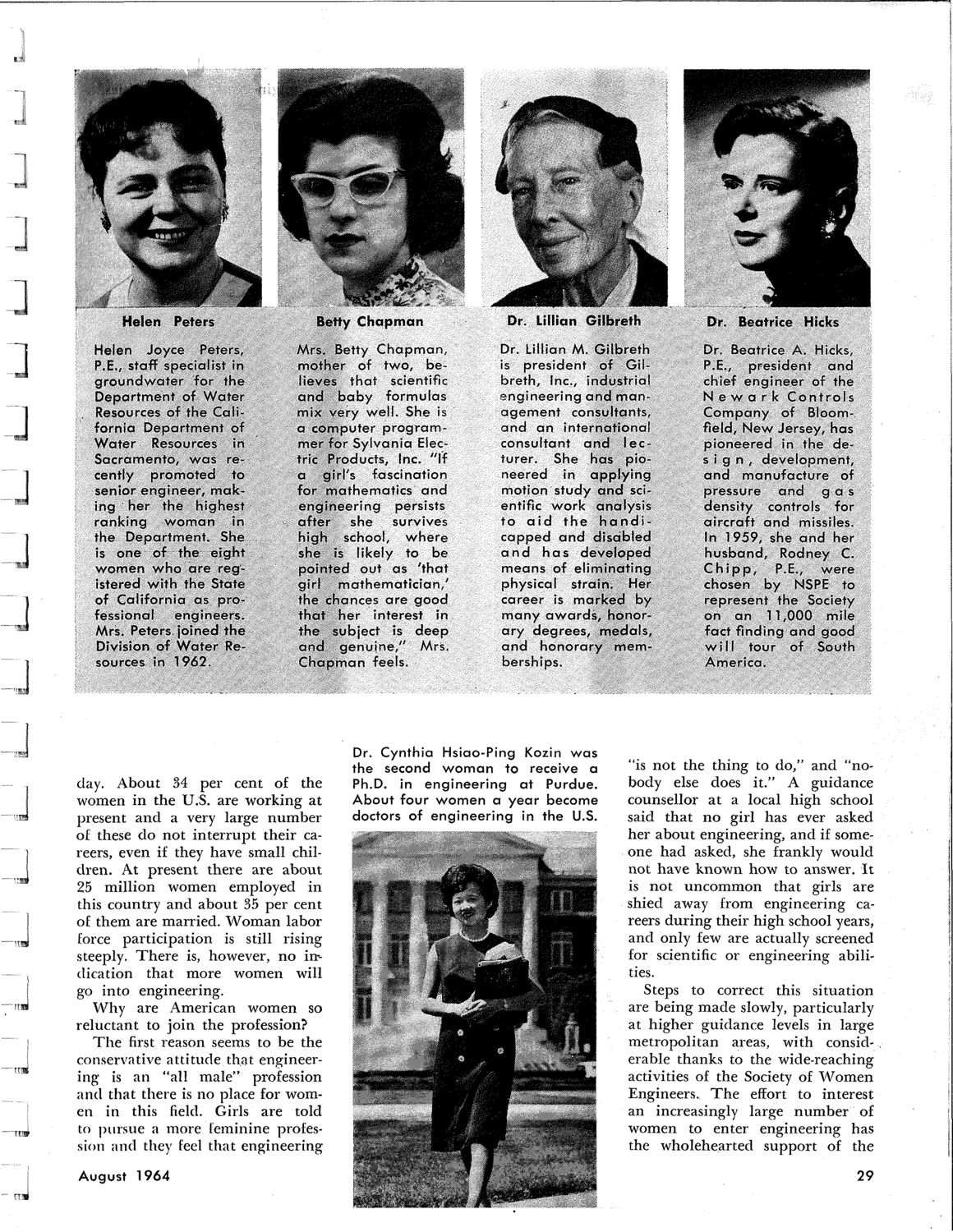| |
| |
Caption: SWE - News Clippings Book
This is a reduced-resolution page image for fast online browsing.

EXTRACTED TEXT FROM PAGE:
Helen Peters Helen Joyce Peters, P.E., staff specialist in groundwater for the Department of Water Resources of the California Department of Water Resources in Sacramento, was recently promoted to senior engineer, making her the highest ranking woman in the Department. She is one of the eight women who are registered with the State of California as professional engineers. Mrs. Peters joined the Division of Water Resources in 1962. Betty Chapman Mrs. Betty Chapman mother of two, be lieves that scientific and baby formulas mix very well. She i. a computer programmer for Sylvania Electric Products, Inc. "If a girl's fascination for mathematics and engineering persists after she survives high school, where she is likely to be pointed out as 'that girl mathematician,' the chances are good that her interest in the subject is deep and genuine," Mrs. Chapman feels. %m./ Dr. Lillian Gilbreth Dr. Lillian M. Gilbreth is president of Gilbreth, Inc., industrial •••ngineering and management consultants, and an international consultant and lecturer. She has pioneered in applying motion study and scientific work analysis to a i d t h e ha n d i capped and disabled a n d has developed means of eliminating physical strain. Her career is marked by many awards, honorary degrees, medals, and honorary memberships. Dr. Beatrice Hicks Dr. Beatrice A. Hicks, P.E., president and chief engineer of the N e w a r k Controls Company of Bloomfield, New Jersey, has pioneered in the des i g n , development, and manufacture of pressure and gas density controls for aircraft and missiles. In 1959, she and her husband, Rodney C. C h i p p , P.E., were chosen by NSPE to represent the Society on an 11,000 mile fact finding and good w i l l tour of South America. clay. About 34 per cent of the women in the U.S. are working at present and a very large number of these do not interrupt their careers, even if they have small children. At present there are about 25 million women employed in this country and about 35 per cent of them are married. Woman labor force participation is still rising steeply. There is, however, no indication that more women will go into engineering. Why are American women so reluctant to join the profession? The first reason seems to be the conservative attitude that engineering is an "all male" profession and that there is no place for women in this field. Girls are told to pursue a more feminine profession and they feel that engineering August 1964 Dr. Cynthia Hsiao-Ping Kozin was the second woman to receive a Ph.D. in engineering at Purdue. About four women a year become doctors of engineering in the U.S. "is not the thing to do," and "nobody else does it." A guidance counsellor at a local high school said that no girl has ever asked her about engineering, and if someone had asked, she frankly would not have known how to answer. It is not uncommon that girls are shied away from engineering careers during their high school years, and only few are actually screened for scientific or engineering abilities. Steps to correct this situation are being made slowly, particularly at higher guidance levels in large metropolitan areas, with considerable thanks to the wide-reaching activities of the Society of Women Engineers. The effort to interest an increasingly large number of women to enter engineering has the wholehearted support of the 29 # »» ,.> •» • * ' ^ ! i ' . '.'"£:-! iiV/*'•'£
| |